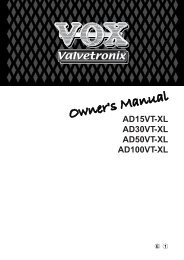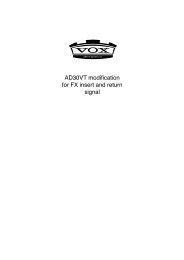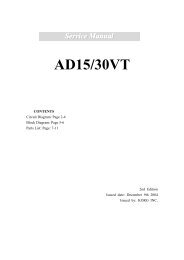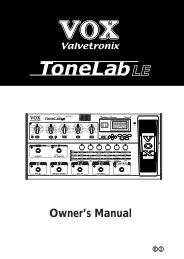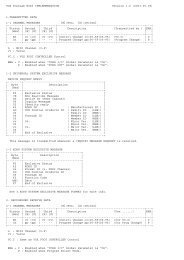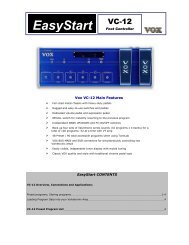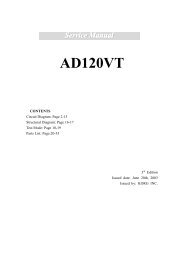ToneLab SE Owner's manual - Vox
ToneLab SE Owner's manual - Vox
ToneLab SE Owner's manual - Vox
You also want an ePaper? Increase the reach of your titles
YUMPU automatically turns print PDFs into web optimized ePapers that Google loves.
darned loud in fact - but it was no match for 1,000 + screaming fans! Remember<br />
folks, back in the late ’50s/early ’60s, guitar amps weren’t being fed through the PA<br />
- that was reserved purely for vocals, the band’s back-line had to do the rest.<br />
Clearly VOX needed to come up with a louder amp and the company was only too<br />
happy to rise to the challenge...<br />
The fruit of VOX’s labour was unveiled to the world in 1959 - the 30 Watt,<br />
2x12, AC30. Several top British bands graduated up to the AC30 instantly and,<br />
within months, one of them had scored a number one single with a stirring guitar<br />
instrumental. Not surprisingly, pretty much every other UK act worth its salt immediately<br />
followed suit and the AC30 became the amp behind the so-called “Beat Boom”<br />
of the time. More importantly, it also became the driving force behind the now legendary<br />
“British Invasion” - the name given to the huge wave of success that several<br />
English bands enjoyed in America during the ’60s. This charge was led by a quartet<br />
hailing from Liverpool who quickly became VOX’s most famous ambassadors ever.<br />
We’ve modelled the sterling sounds of the AC30’s Normal channel as they definitely<br />
encapsulate those classic tones that defined the aforementioned British invasion.<br />
Just like its smaller brother, the AC15, the AC30’s Normal channel boasts the bare minimum<br />
of knobs - Volume and Top Cut (modelled by GAIN and PRE<strong>SE</strong>NCE* respectively).<br />
*CONTROL NOTE: Once again, our PRE<strong>SE</strong>NCE control models the “Top Cut” on<br />
the original AC30 exactly - except in reverse (“off” = cut) to make it more logical,<br />
just like on our AC15 model.<br />
Original’s valve compliment: 4 x ECC83s, 1 x ECC82 in the preamp, 1 x<br />
GZ34 rectifier, 4 x EL84s in the power amp.<br />
4. AC30TB<br />
Even though the AC30 was a runaway success, several artists expressed a desire for the<br />
amp to have more tonal flexibility and a pinch of extra gain too. VOX reacted quickly and<br />
came up with some clever extra tone circuitry that featured an additional ECC83 valve<br />
and was called “Top Boost.”* When “Top Boost” was added to an AC30 it increased the<br />
gain of the combo’s Brilliant channel, and added two extra EQ controls, giving the amp<br />
three tone controls -Treble, Bass and Cut. To say it was an instant hit with the guitar playing<br />
public would be a gross understatement! In fact, its gutsy tone became an instantly<br />
recognisable signature sound of many major groups in the mid ’60s.<br />
NERDY HISTORICAL NOTE: VOX initially called this their “Brilliance Unit” but it<br />
quickly became known as “Top Boost.” When Top Boost was first introduced it was<br />
only available as a retrofit assembly. Even though this modification was not particularly<br />
difficult to add, it was beyond most folk (hey, I don’t know about you, but messing<br />
around with electricity is hardly my idea of fun!). Consequently, in 1964, Top<br />
Boost was fitted to the AC30 as standard.<br />
Once again, the PRE<strong>SE</strong>NCE control of our model acts as the original’s Cut<br />
(but in reverse: “off” = cut) while the GAIN, TREBLE and BASS mimic the original’s<br />
Volume, Treble and Bass controls. The MIDDLE is an “extra” with 12 o’clock being<br />
its “neutral” position.<br />
Our AC30TB model produces clean sounds that are rich and jangly with a<br />
smooth yet detailed top end, and overdrives that have a glorious, throaty bark -<br />
just like those classic, “Class A” tones that have made the original a “must have” in<br />
any serious player’s amp collection.<br />
27<br />
REVERB DELAY MODULATION PEDAL CABINET AMP TYPE Amp/Effect<br />
TYPE




